University Nursing: Clinical Reasoning Report on Patient Mrs. Chivers
VerifiedAdded on 2023/01/11
|6
|1325
|70
Report
AI Summary
This nursing assignment presents a clinical reasoning report based on a case study of Mrs. Roseanne Chivers, a 63-year-old widow experiencing her first ocean swim. The report analyzes objective and subjective assessment data, including vital signs and patient symptoms like shivering and cold hands, to identify potential issues. The student nurse applies the first three phases of the clinical reasoning process, interpreting cues, processing information, and identifying the problem of potential Raynaud's phenomenon. The report explores the patient's medical history, including the recent loss of her husband, and links this to potential stress factors. It then outlines goals, such as restoring normal finger color and pain-free verbalization, and suggests actions like avoiding cold exposure, cessation of smoking, and potential drug interventions. The assignment references relevant literature to support the analysis and recommendations, demonstrating the application of clinical reasoning to a nursing scenario. The report concludes by discussing the need for further data collection to clarify the patient's medical history and rule out potential causes of the patient's symptoms.
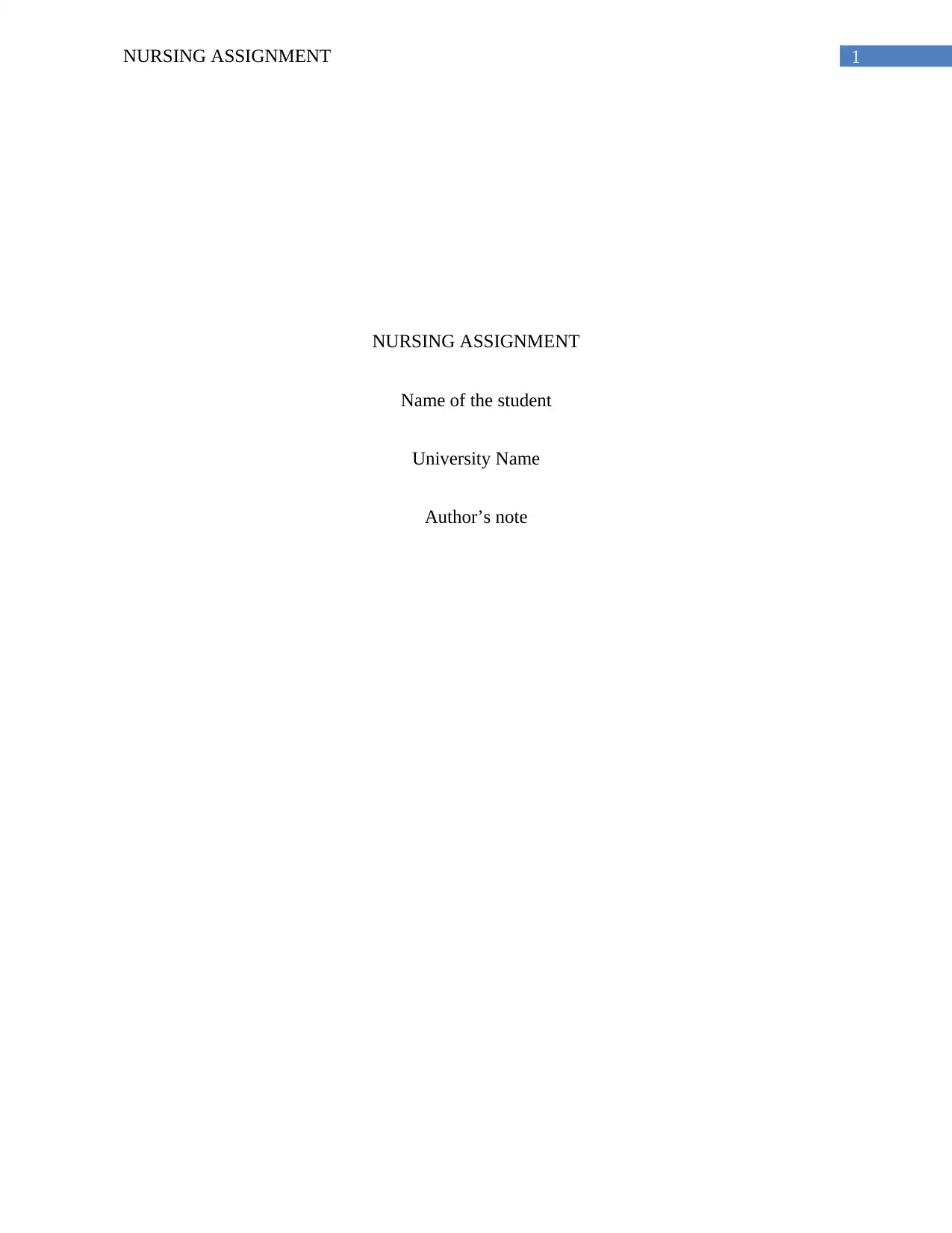
1NURSING ASSIGNMENT
NURSING ASSIGNMENT
Name of the student
University Name
Author’s note
NURSING ASSIGNMENT
Name of the student
University Name
Author’s note
Paraphrase This Document
Need a fresh take? Get an instant paraphrase of this document with our AI Paraphraser
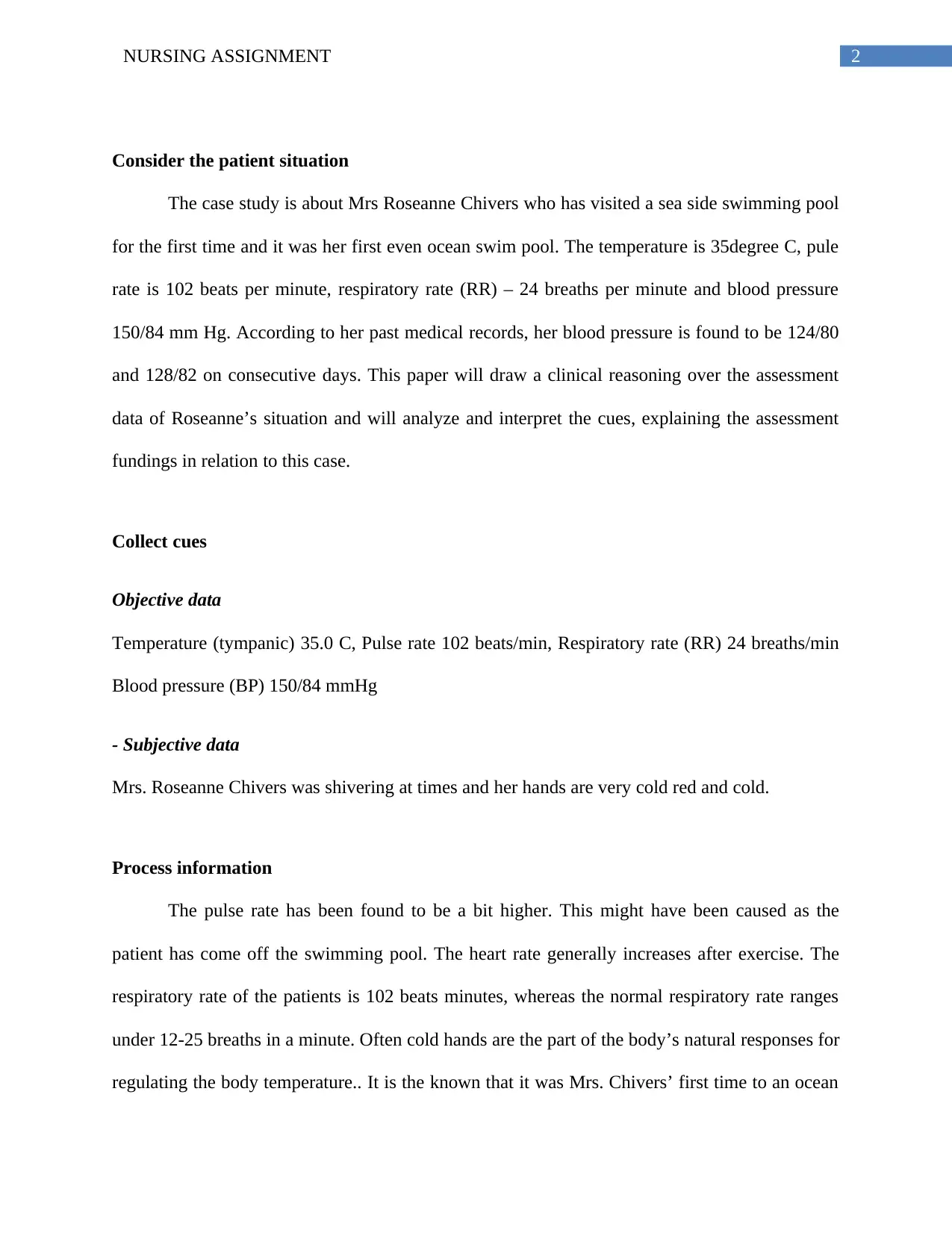
2NURSING ASSIGNMENT
Consider the patient situation
The case study is about Mrs Roseanne Chivers who has visited a sea side swimming pool
for the first time and it was her first even ocean swim pool. The temperature is 35degree C, pule
rate is 102 beats per minute, respiratory rate (RR) – 24 breaths per minute and blood pressure
150/84 mm Hg. According to her past medical records, her blood pressure is found to be 124/80
and 128/82 on consecutive days. This paper will draw a clinical reasoning over the assessment
data of Roseanne’s situation and will analyze and interpret the cues, explaining the assessment
fundings in relation to this case.
Collect cues
Objective data
Temperature (tympanic) 35.0 C, Pulse rate 102 beats/min, Respiratory rate (RR) 24 breaths/min
Blood pressure (BP) 150/84 mmHg
- Subjective data
Mrs. Roseanne Chivers was shivering at times and her hands are very cold red and cold.
Process information
The pulse rate has been found to be a bit higher. This might have been caused as the
patient has come off the swimming pool. The heart rate generally increases after exercise. The
respiratory rate of the patients is 102 beats minutes, whereas the normal respiratory rate ranges
under 12-25 breaths in a minute. Often cold hands are the part of the body’s natural responses for
regulating the body temperature.. It is the known that it was Mrs. Chivers’ first time to an ocean
Consider the patient situation
The case study is about Mrs Roseanne Chivers who has visited a sea side swimming pool
for the first time and it was her first even ocean swim pool. The temperature is 35degree C, pule
rate is 102 beats per minute, respiratory rate (RR) – 24 breaths per minute and blood pressure
150/84 mm Hg. According to her past medical records, her blood pressure is found to be 124/80
and 128/82 on consecutive days. This paper will draw a clinical reasoning over the assessment
data of Roseanne’s situation and will analyze and interpret the cues, explaining the assessment
fundings in relation to this case.
Collect cues
Objective data
Temperature (tympanic) 35.0 C, Pulse rate 102 beats/min, Respiratory rate (RR) 24 breaths/min
Blood pressure (BP) 150/84 mmHg
- Subjective data
Mrs. Roseanne Chivers was shivering at times and her hands are very cold red and cold.
Process information
The pulse rate has been found to be a bit higher. This might have been caused as the
patient has come off the swimming pool. The heart rate generally increases after exercise. The
respiratory rate of the patients is 102 beats minutes, whereas the normal respiratory rate ranges
under 12-25 breaths in a minute. Often cold hands are the part of the body’s natural responses for
regulating the body temperature.. It is the known that it was Mrs. Chivers’ first time to an ocean
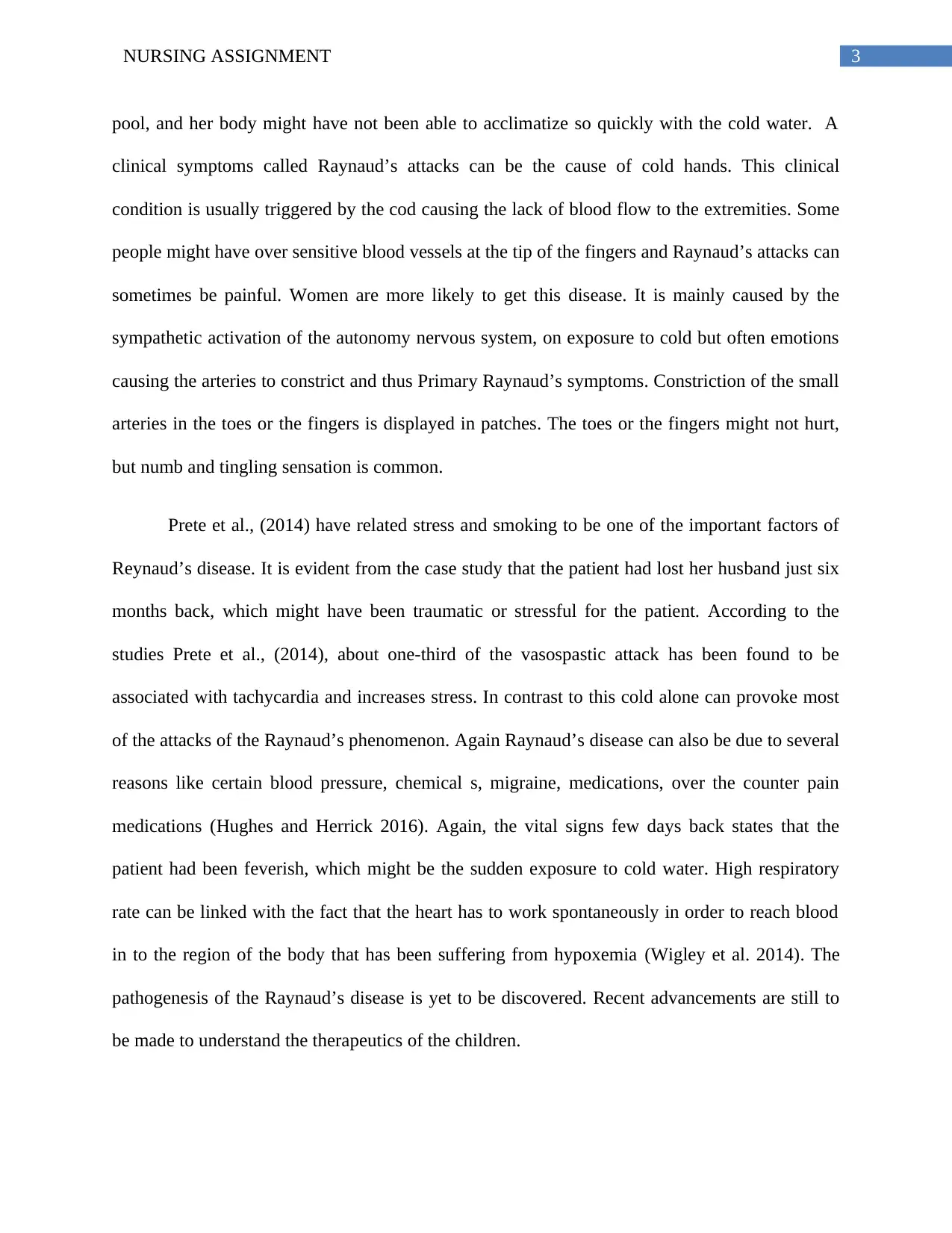
3NURSING ASSIGNMENT
pool, and her body might have not been able to acclimatize so quickly with the cold water. A
clinical symptoms called Raynaud’s attacks can be the cause of cold hands. This clinical
condition is usually triggered by the cod causing the lack of blood flow to the extremities. Some
people might have over sensitive blood vessels at the tip of the fingers and Raynaud’s attacks can
sometimes be painful. Women are more likely to get this disease. It is mainly caused by the
sympathetic activation of the autonomy nervous system, on exposure to cold but often emotions
causing the arteries to constrict and thus Primary Raynaud’s symptoms. Constriction of the small
arteries in the toes or the fingers is displayed in patches. The toes or the fingers might not hurt,
but numb and tingling sensation is common.
Prete et al., (2014) have related stress and smoking to be one of the important factors of
Reynaud’s disease. It is evident from the case study that the patient had lost her husband just six
months back, which might have been traumatic or stressful for the patient. According to the
studies Prete et al., (2014), about one-third of the vasospastic attack has been found to be
associated with tachycardia and increases stress. In contrast to this cold alone can provoke most
of the attacks of the Raynaud’s phenomenon. Again Raynaud’s disease can also be due to several
reasons like certain blood pressure, chemical s, migraine, medications, over the counter pain
medications (Hughes and Herrick 2016). Again, the vital signs few days back states that the
patient had been feverish, which might be the sudden exposure to cold water. High respiratory
rate can be linked with the fact that the heart has to work spontaneously in order to reach blood
in to the region of the body that has been suffering from hypoxemia (Wigley et al. 2014). The
pathogenesis of the Raynaud’s disease is yet to be discovered. Recent advancements are still to
be made to understand the therapeutics of the children.
pool, and her body might have not been able to acclimatize so quickly with the cold water. A
clinical symptoms called Raynaud’s attacks can be the cause of cold hands. This clinical
condition is usually triggered by the cod causing the lack of blood flow to the extremities. Some
people might have over sensitive blood vessels at the tip of the fingers and Raynaud’s attacks can
sometimes be painful. Women are more likely to get this disease. It is mainly caused by the
sympathetic activation of the autonomy nervous system, on exposure to cold but often emotions
causing the arteries to constrict and thus Primary Raynaud’s symptoms. Constriction of the small
arteries in the toes or the fingers is displayed in patches. The toes or the fingers might not hurt,
but numb and tingling sensation is common.
Prete et al., (2014) have related stress and smoking to be one of the important factors of
Reynaud’s disease. It is evident from the case study that the patient had lost her husband just six
months back, which might have been traumatic or stressful for the patient. According to the
studies Prete et al., (2014), about one-third of the vasospastic attack has been found to be
associated with tachycardia and increases stress. In contrast to this cold alone can provoke most
of the attacks of the Raynaud’s phenomenon. Again Raynaud’s disease can also be due to several
reasons like certain blood pressure, chemical s, migraine, medications, over the counter pain
medications (Hughes and Herrick 2016). Again, the vital signs few days back states that the
patient had been feverish, which might be the sudden exposure to cold water. High respiratory
rate can be linked with the fact that the heart has to work spontaneously in order to reach blood
in to the region of the body that has been suffering from hypoxemia (Wigley et al. 2014). The
pathogenesis of the Raynaud’s disease is yet to be discovered. Recent advancements are still to
be made to understand the therapeutics of the children.
⊘ This is a preview!⊘
Do you want full access?
Subscribe today to unlock all pages.

Trusted by 1+ million students worldwide
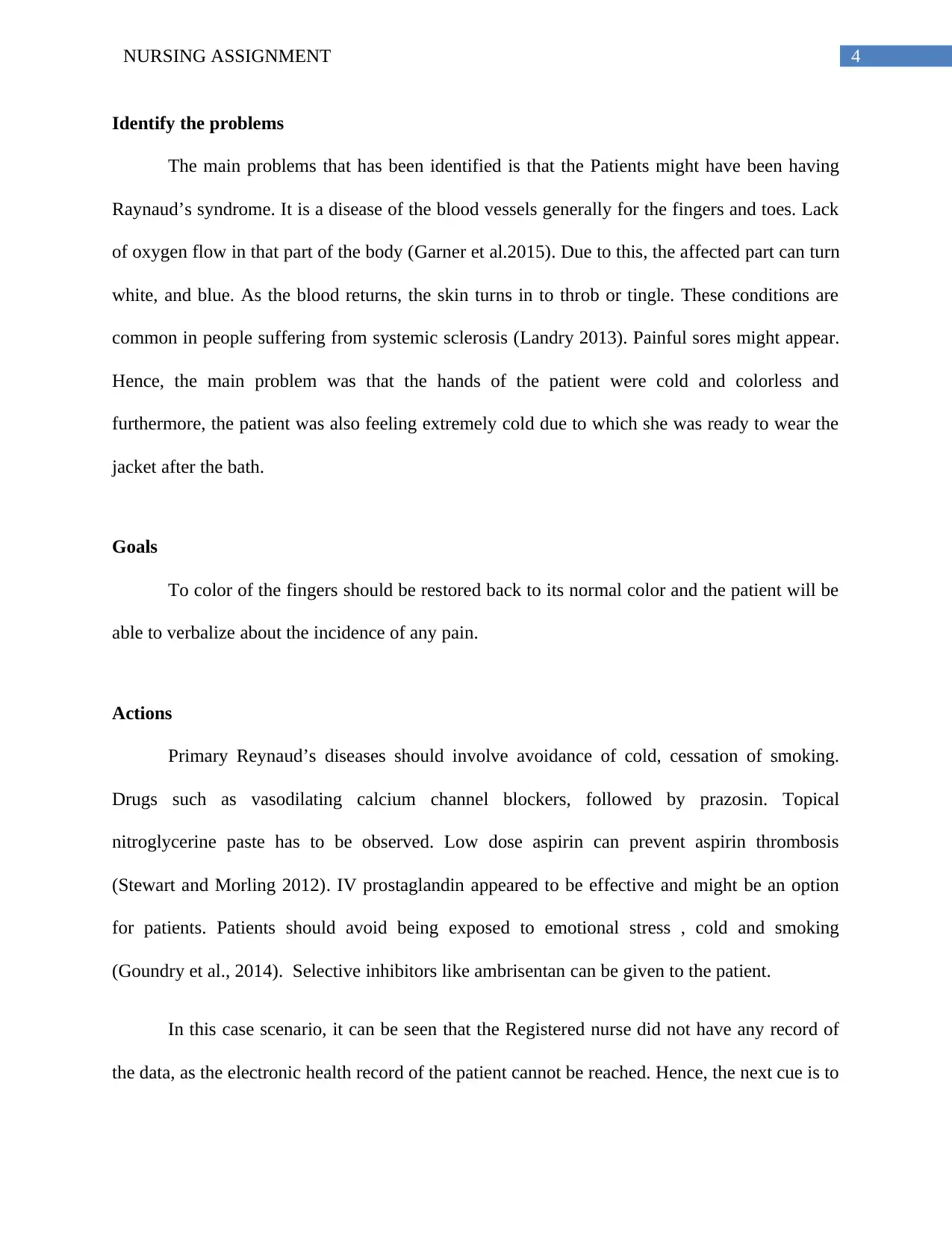
4NURSING ASSIGNMENT
Identify the problems
The main problems that has been identified is that the Patients might have been having
Raynaud’s syndrome. It is a disease of the blood vessels generally for the fingers and toes. Lack
of oxygen flow in that part of the body (Garner et al.2015). Due to this, the affected part can turn
white, and blue. As the blood returns, the skin turns in to throb or tingle. These conditions are
common in people suffering from systemic sclerosis (Landry 2013). Painful sores might appear.
Hence, the main problem was that the hands of the patient were cold and colorless and
furthermore, the patient was also feeling extremely cold due to which she was ready to wear the
jacket after the bath.
Goals
To color of the fingers should be restored back to its normal color and the patient will be
able to verbalize about the incidence of any pain.
Actions
Primary Reynaud’s diseases should involve avoidance of cold, cessation of smoking.
Drugs such as vasodilating calcium channel blockers, followed by prazosin. Topical
nitroglycerine paste has to be observed. Low dose aspirin can prevent aspirin thrombosis
(Stewart and Morling 2012). IV prostaglandin appeared to be effective and might be an option
for patients. Patients should avoid being exposed to emotional stress , cold and smoking
(Goundry et al., 2014). Selective inhibitors like ambrisentan can be given to the patient.
In this case scenario, it can be seen that the Registered nurse did not have any record of
the data, as the electronic health record of the patient cannot be reached. Hence, the next cue is to
Identify the problems
The main problems that has been identified is that the Patients might have been having
Raynaud’s syndrome. It is a disease of the blood vessels generally for the fingers and toes. Lack
of oxygen flow in that part of the body (Garner et al.2015). Due to this, the affected part can turn
white, and blue. As the blood returns, the skin turns in to throb or tingle. These conditions are
common in people suffering from systemic sclerosis (Landry 2013). Painful sores might appear.
Hence, the main problem was that the hands of the patient were cold and colorless and
furthermore, the patient was also feeling extremely cold due to which she was ready to wear the
jacket after the bath.
Goals
To color of the fingers should be restored back to its normal color and the patient will be
able to verbalize about the incidence of any pain.
Actions
Primary Reynaud’s diseases should involve avoidance of cold, cessation of smoking.
Drugs such as vasodilating calcium channel blockers, followed by prazosin. Topical
nitroglycerine paste has to be observed. Low dose aspirin can prevent aspirin thrombosis
(Stewart and Morling 2012). IV prostaglandin appeared to be effective and might be an option
for patients. Patients should avoid being exposed to emotional stress , cold and smoking
(Goundry et al., 2014). Selective inhibitors like ambrisentan can be given to the patient.
In this case scenario, it can be seen that the Registered nurse did not have any record of
the data, as the electronic health record of the patient cannot be reached. Hence, the next cue is to
Paraphrase This Document
Need a fresh take? Get an instant paraphrase of this document with our AI Paraphraser
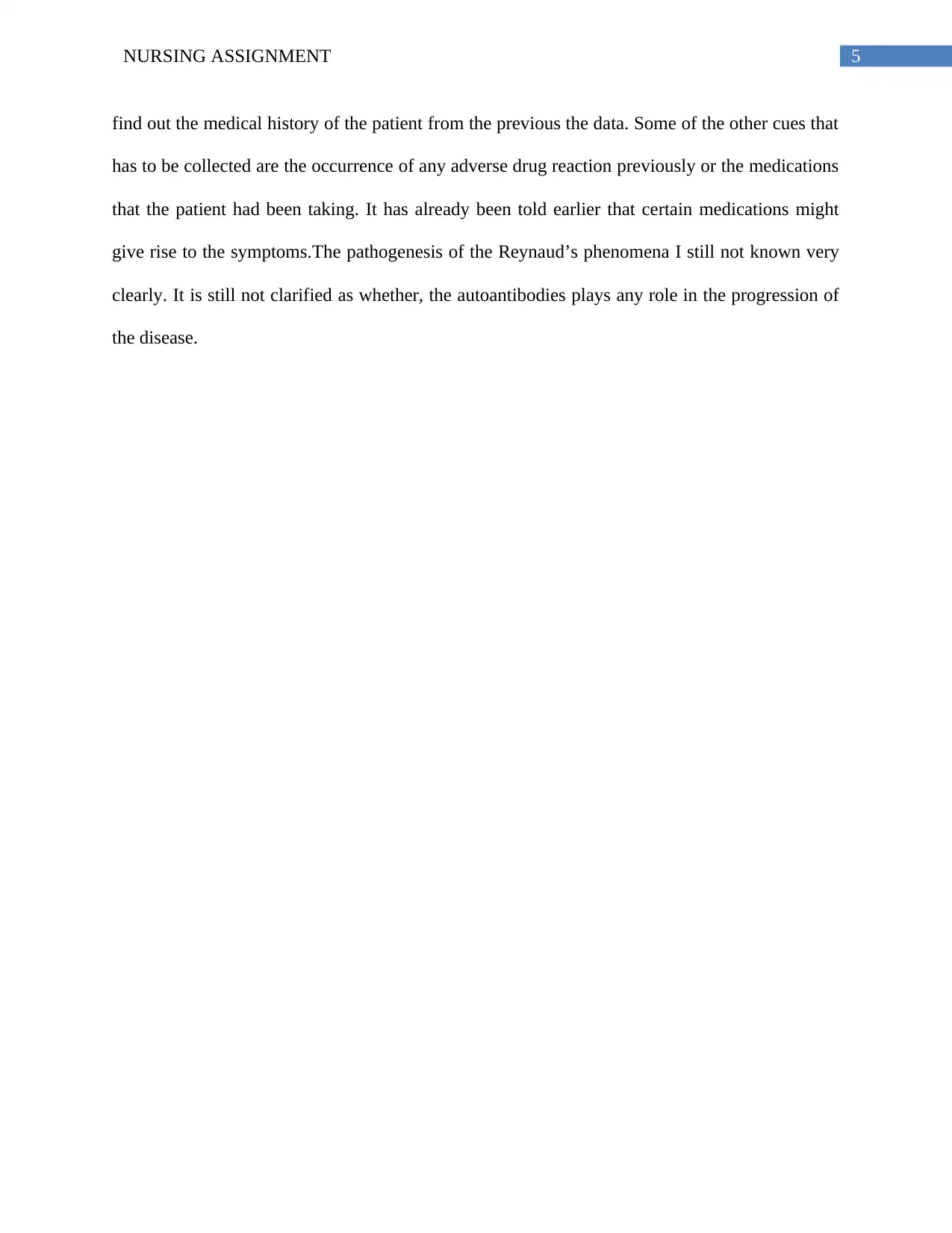
5NURSING ASSIGNMENT
find out the medical history of the patient from the previous the data. Some of the other cues that
has to be collected are the occurrence of any adverse drug reaction previously or the medications
that the patient had been taking. It has already been told earlier that certain medications might
give rise to the symptoms.The pathogenesis of the Reynaud’s phenomena I still not known very
clearly. It is still not clarified as whether, the autoantibodies plays any role in the progression of
the disease.
find out the medical history of the patient from the previous the data. Some of the other cues that
has to be collected are the occurrence of any adverse drug reaction previously or the medications
that the patient had been taking. It has already been told earlier that certain medications might
give rise to the symptoms.The pathogenesis of the Reynaud’s phenomena I still not known very
clearly. It is still not clarified as whether, the autoantibodies plays any role in the progression of
the disease.
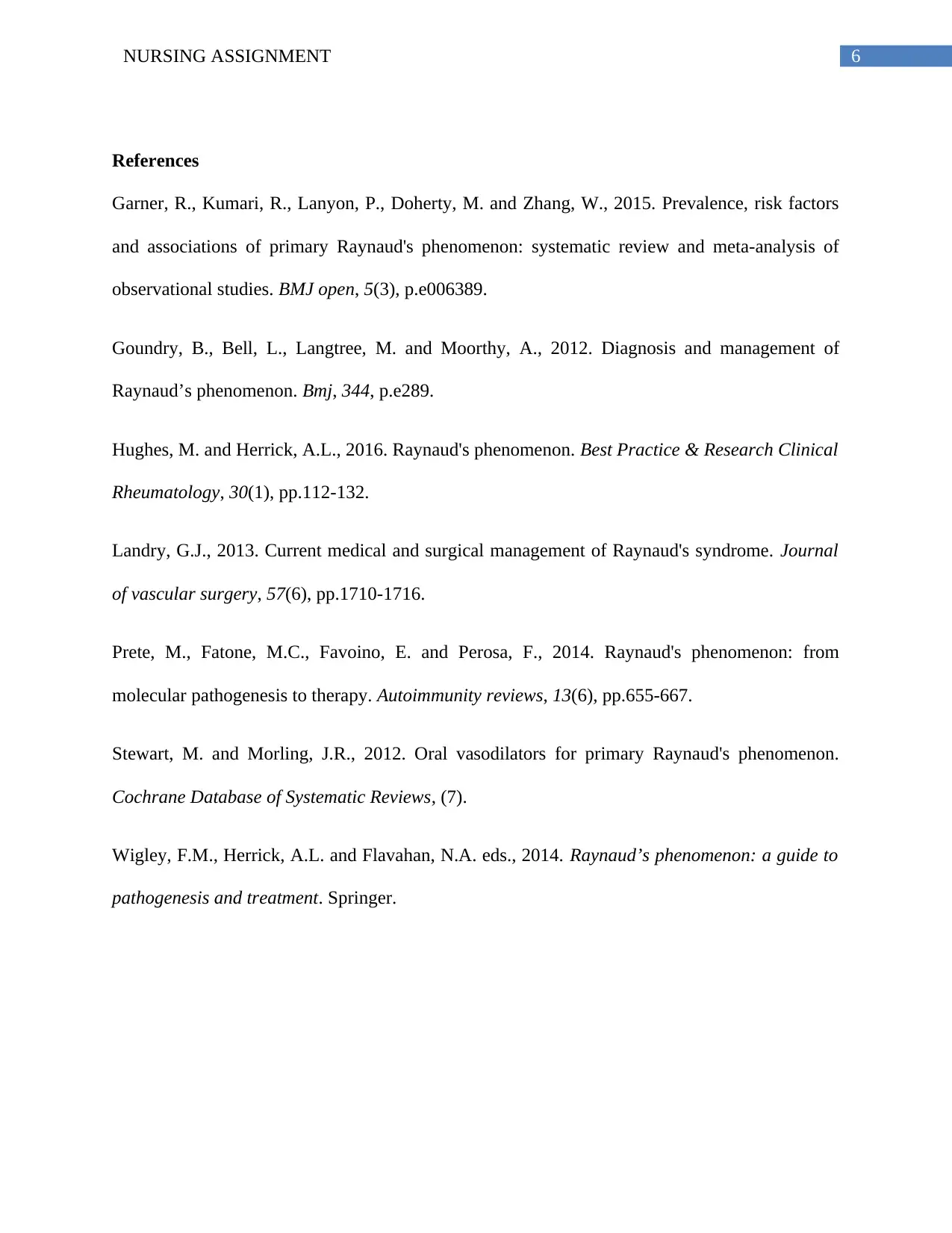
6NURSING ASSIGNMENT
References
Garner, R., Kumari, R., Lanyon, P., Doherty, M. and Zhang, W., 2015. Prevalence, risk factors
and associations of primary Raynaud's phenomenon: systematic review and meta-analysis of
observational studies. BMJ open, 5(3), p.e006389.
Goundry, B., Bell, L., Langtree, M. and Moorthy, A., 2012. Diagnosis and management of
Raynaud’s phenomenon. Bmj, 344, p.e289.
Hughes, M. and Herrick, A.L., 2016. Raynaud's phenomenon. Best Practice & Research Clinical
Rheumatology, 30(1), pp.112-132.
Landry, G.J., 2013. Current medical and surgical management of Raynaud's syndrome. Journal
of vascular surgery, 57(6), pp.1710-1716.
Prete, M., Fatone, M.C., Favoino, E. and Perosa, F., 2014. Raynaud's phenomenon: from
molecular pathogenesis to therapy. Autoimmunity reviews, 13(6), pp.655-667.
Stewart, M. and Morling, J.R., 2012. Oral vasodilators for primary Raynaud's phenomenon.
Cochrane Database of Systematic Reviews, (7).
Wigley, F.M., Herrick, A.L. and Flavahan, N.A. eds., 2014. Raynaud’s phenomenon: a guide to
pathogenesis and treatment. Springer.
References
Garner, R., Kumari, R., Lanyon, P., Doherty, M. and Zhang, W., 2015. Prevalence, risk factors
and associations of primary Raynaud's phenomenon: systematic review and meta-analysis of
observational studies. BMJ open, 5(3), p.e006389.
Goundry, B., Bell, L., Langtree, M. and Moorthy, A., 2012. Diagnosis and management of
Raynaud’s phenomenon. Bmj, 344, p.e289.
Hughes, M. and Herrick, A.L., 2016. Raynaud's phenomenon. Best Practice & Research Clinical
Rheumatology, 30(1), pp.112-132.
Landry, G.J., 2013. Current medical and surgical management of Raynaud's syndrome. Journal
of vascular surgery, 57(6), pp.1710-1716.
Prete, M., Fatone, M.C., Favoino, E. and Perosa, F., 2014. Raynaud's phenomenon: from
molecular pathogenesis to therapy. Autoimmunity reviews, 13(6), pp.655-667.
Stewart, M. and Morling, J.R., 2012. Oral vasodilators for primary Raynaud's phenomenon.
Cochrane Database of Systematic Reviews, (7).
Wigley, F.M., Herrick, A.L. and Flavahan, N.A. eds., 2014. Raynaud’s phenomenon: a guide to
pathogenesis and treatment. Springer.
⊘ This is a preview!⊘
Do you want full access?
Subscribe today to unlock all pages.

Trusted by 1+ million students worldwide
1 out of 6
Related Documents
Your All-in-One AI-Powered Toolkit for Academic Success.
+13062052269
info@desklib.com
Available 24*7 on WhatsApp / Email
![[object Object]](/_next/static/media/star-bottom.7253800d.svg)
Unlock your academic potential
Copyright © 2020–2025 A2Z Services. All Rights Reserved. Developed and managed by ZUCOL.





